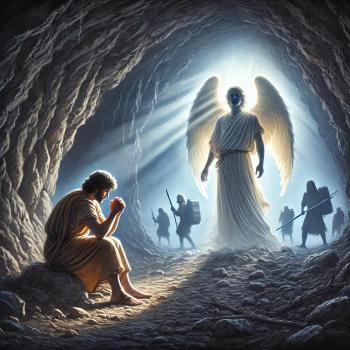1 Peter 1:1-12 Life’s Journey
We are temporary residents
“Peter, an apostle of Jesus Christ: To the temporary residents dispersed in Pontus, Galatia, Cappadocia, Asia, and Bithynia, chosen” (1 Peter 1:1, HCSB)
Peter is an apostle, which means one who is sent. Peter is the “apostle of hope.” More than anyone else, Peter stresses hope as the answer to persecution and difficulty. Paul is the “apostle of faith,” as he articulates more clearly than any other writer the doctrine of justification by faith. John is known both through his person and writing as the “apostle of love.” Faith, hope, and love are personified in Paul, Peter, and John—all apostles of Jesus Christ.1
Peter called them “strangers” (1 Peter 1:1), which means “resident aliens, sojourners.” They are called “strangers and pilgrims” in 1 Peter 2:11. These people were citizens of heaven through faith in Christ (Phil. 3:20), and therefore were not permanent residents on earth. Like Abraham, they had their eyes of faith centered on the future city of God (Heb. 11:8–16). They were in the world, but not of the world (John 17:16).2
A temporary resident is someone who does not or can not stay in a certain location. Basically it is someone who is on a journey. The Bible is full of journey stories – forced and unforced. Adam and Eve don’t stay in the garden long. Noah moves along on a boat. Abraham goes on a foreign trip. Joseph and forcibly removed from his family. Jacob is forced out by famine. That’s just Genesis. Then we have the Exodus.
We go to the New Testament and even Jesus is a moving figure. He even said:
“Jesus told him, “Foxes have dens and birds of the sky have nests, but the Son of Man has no place to lay His head.”” (Matthew 8:20, HCSB)
He moves around from birth to death. From Bethlehem to Calvary, and every point in between. Jesus is a moving ministry. The early church discovered that they have to keep moving. That is what is happening to these residents. They are moving physically from Jerusalem to those locations. They are also moving in faith. You and I are temporary residents on a faith journey. A stranger is away from home, but a pilgrim is on the way home.3
People who are temporary residents on a journey usually risk imprisonment. There is a risk to being a temporary resident. However, as Christians we have a heavenly TSA helping us. The Trinitarian Security Agency (TSA) helps us on our journey. Notice the following:
“according to the foreknowledge of God the Father and set apart by the Spirit for obedience and for sprinkling with the blood of Jesus Christ. May grace and peace be multiplied to you.” (1 Peter 1:2, HCSB)
We have God the Father, the Son and the Holy Spirit all working to help us on our journey. When you are on a faith journey, you don’t travel alone. You have some spiritual bodyguards helping you.
What does that faith look like? Here are three pictures:
THREE PICTURES OF OUR FAITH
“Praise the God and Father of our Lord Jesus Christ. According to His great mercy, He has given us a new birth into a living hope through the resurrection of Jesus Christ from the dead and into an inheritance that is imperishable, uncorrupted, and unfading, kept in heaven for you.” (1 Peter 1:3–4, HCSB)
Peter compares our faith to three pictures:
Our faith is like a birth.
Our faith is a resurrection.
Our faith has an inheritance.
Notice that these three pictures underscore the fact that our faith is secure. We have a new birth, one in which we won’t eternally die. We have a resurrection, and we have an inheritance. Don’t you like that. There is a pot of gold at the end of this rainbow journey.
We have talked out our status (temporary residents), our travel body guards (the Trinity), and we have viewed pictures of what our journey will look like. Now let’s look at the map. Peter tells us that our faith trek will go in a certain direction. He has shown us a secure path for our journey.
SECURE DIRECTION FOR OUR FAITH
The journey is protected by God’s power.
“You are being protected by God’s power through faith for a salvation that is ready to be revealed in the last time.” (1 Peter 1:5, HCSB)
As Curtis Vaughan states: We have already been begotten to it and are now being “guarded” (kept safe) until we experience its full manifestation “in the last time.”4
The journey is a difficult one. It has some rough places where we will suffer.
“You rejoice in this, though now for a short time you have had to struggle in various trials so that the genuineness of your faith —more valuable than gold, which perishes though refined by fire —may result in praise, glory, and honor at the revelation of Jesus Christ.” (1 Peter 1:6–7, HCSB)
Through Athens, Greece, runs one of the world’s refugee highways, on which millions of desperate people travel after being forced from their homelands by violence, terror, and persecution. These refugees seek a safe place to end their journey and begin new lives in freedom and silence. In May 2006, a missionary in Athens, Kallie Skaife, reported what happened to an Iranian man identified as “M”:
In 2003, everything M knew was destroyed by an earthquake measuring 7.45 on the Richter scale. He was tortured by the question of why something like this would happen. He went to live with relatives in Afghanistan, was married, and had a daughter. But he was still filled with despair.
Leaving his family behind, M headed west and ended up in Athens, staying with other relatives. Though he and all his family were Muslims, M became interested in Christianity, finding himself strangely drawn to the crosses he saw decorating the Orthodox churches in the city. M was given a Bible and started reading. Since his relatives forbade such a thing, M used a tiny flashlight to read during the night after his uncles were asleep.
He studied the Bible this way for two years. Finally, M realized God was calling him to be born again. He contacted the refugee ministry center, declared his faith in Christ, and asked for more information.
On Sunday, May 7, 2006, M set his alarm for 6:00 a.m. He wanted to spend time reading his Bible and praying because on that day he was to be baptized at a fellowship with other Iranian believers. But M’s cousin had discovered the plan. Before M’s alarm went off, the cousin boiled water in a saucepan and poured it on M while he slept, scalding both thighs and one arm.
M came to the baptism anyway. Standing before those gathered, the burn on his arm clearly visible, M declared, “No matter what they do to me, I will love Jesus.”5
Parts of the journey are hard to see.
“You love Him, though you have not seen Him. And though not seeing Him now, you believe in Him and rejoice with inexpressible and glorious joy,” (1 Peter 1:8, HCSB)
The end location of our journey and path there are secure. There are no wash-outs, no broken bridges, no objects to make us quit this journey.
“because you are receiving the goal of your faith, the salvation of your souls.” (1 Peter 1:9, HCSB)
Yes, there are people who think they have to turn back. However, Jesus encourages us to continue. He has given us a salvation that makes our faith journey secure and safe in the end.
A SECURE SALVATION
This end salvation has been prophesied, preaches, and even envied.
God revealed to the Old Testament prophets about the fact that we would have this journey which would be secured by Jesus.
“Concerning this salvation, the prophets who prophesied about the grace that would come to you searched and carefully investigated. They inquired into what time or what circumstances the Spirit of Christ within them was indicating when He testified in advance to the messianic sufferings and the glories that would follow.” (1 Peter 1:10–11, HCSB)
People have preached about it.
“…These things have now been announced to you through those who preached the gospel to you by the Holy Spirit sent from heaven…” (1 Peter 1:12, HCSB)
Angels have looked into it with envy.
“…Angels desire to look into these things.” (1 Peter 1:12, HCSB)
Our salvation is secure. Therefore, we know we can reach life’s destination without fear. This attitude, which doesn’t come as a “I know it all” attitude, will help people to see Christ in you. Your journey is a collective journey. We are all following Christ as He leads us to our eternal home.
BIBLIOGRAPHY
Courson, Jon. Jon Courson’s Application Commentary. Nashville, TN: Thomas Nelson, 2003.
Larson, Craig Brian, and Phyllis Ten Elshof. 1001 Illustrations That Connect. Grand Rapids, MI: Zondervan Publishing House, 2008.
Vaughan, Curtis. “1 Peter.” In The Teacher’s Bible Commentary, edited by H. Franklin Paschall and Herschel H. Hobbs. Nashville: Broadman and Holman Publishers, 1972.
Wiersbe, Warren W. Be What You Are: 12 Intriguing Pictures of the Christian from the New Testament. Wheaton, IL: Tyndale House, 1988.
________________. The Bible Exposition Commentary. Wheaton, IL: Victor Books, 1996.
1 Jon Courson, Jon Courson’s Application Commentary (Nashville, TN: Thomas Nelson, 2003), 1542.
2 Warren W. Wiersbe, The Bible Exposition Commentary, vol. 2 (Wheaton, IL: Victor Books, 1996), 389.
3 Warren W. Wiersbe, Be What You Are: 12 Intriguing Pictures of the Christian from the New Testament (Wheaton, IL: Tyndale House, 1988), 43.
4 Curtis Vaughan, “1 Peter,” in The Teacher’s Bible Commentary, ed. H. Franklin Paschall and Herschel H. Hobbs (Nashville: Broadman and Holman Publishers, 1972), 785.
5 Craig Brian Larson and Phyllis Ten Elshof, 1001 Illustrations That Connect (Grand Rapids, MI: Zondervan Publishing House, 2008), 444.















